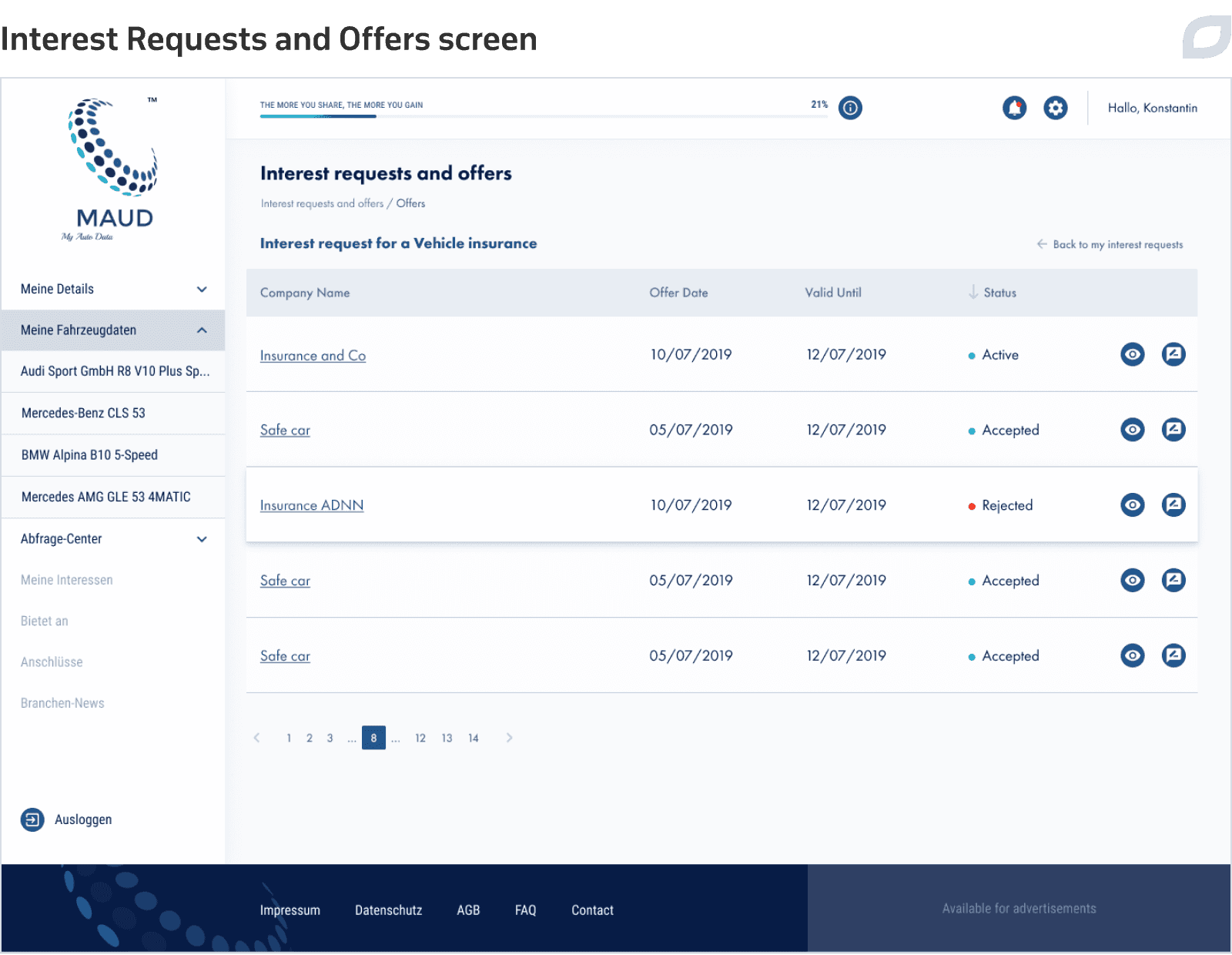
Vehicle data platform for an automotive startup
Itransition delivered a SaaS platform and mobile applications that transform the way vehicle owners and companies work together for mutual benefit.
Table of contents
Challenge
Our customer, the German startup MyAutoData (MAUD), aimed to create an online platform that would bring together vehicle owners and automotive companies, providing a range of services for both groups of users.
For vehicle owners, the platform would make it possible to track and manage their vehicle- and driving-related data securely in a centralized digital storage, with the option to sell this data to companies for marketing purposes. Meanwhile, automotive companies could use the platform to access marketed user data and generate sales through targeted offers and personalized deals.
Due to Itransition’s solid experience in automotive software development, MyAutoData partnered with us to carry out the project.
Solution
Itransition developed a web platform that allows vehicle owners to securely collect, manage, and market their vehicle-related data under either a basic or premium plan.
Vehicle owners can store their vehicle-related data (e.g., insurance, registration, financing details, etc.) in a digitally encrypted form and analyze it directly on the platform. It’s also possible to verify a user’s vehicle to unlock the full features of the service. The data released on the platform is anonymized and can be revoked anytime.
On the other hand, participating companies (car dealers, car insurers, leasing companies, insurance companies, garages, etc.) can buy the data that vehicle owners have opted for selling directly on the platform.
Mobile apps for vehicle data management
To enable the tracking and management of trip- and driving-related data, Itransition’s mobility specialists developed mobile apps for both iOS and Android, available to premium users. MyAutoData provides each premium user with an OBD2 dongle, a small globally standardized adapter through which most types of vehicle data can be read and made available on the platform.
Via the app, vehicle owners can track the distance traveled, speed, ambient temperature, battery charge level, acceleration, harsh braking, and more. This data is refreshed every 2 seconds and is stored on the platform for 180 days.

The application’s logic is the following:
- Before the start of a trip, a user plugs in the OBD2 dongle in the socket of their car, connects the dongle to the mobile app via Bluetooth, selects driving behavior (private, business, additional drivers), and sends the current odometer value.
- The dongle automatically checks whether the vehicle is identical to the one entered in the user account by identifying its VIN (vehicle identification number).
- When the car starts moving, the app sets the timer and starts reading the user's vehicle data. If the connection is lost during the trip, all the data is transferred to a local database. Every trip has its own identifier, and all measured parameters related to the trip ID will be uploaded when the internet connection is recovered.
The data is transferred directly without the involvement of any third party with the OBD2 dongle via Bluetooth and stored in the local database of the mobile application. Then, from the local database, it is securely placed in the vehicle owner's account via the cloud, appearing as historical data.

The application works automatically in the background even when the device is locked, requiring minimum user intervention. It's capable of defining a trip's starting and stopping points, recovering the Bluetooth connection, and initializing an OBD2 connection to interact with the vehicle diagnostic system.
Data analytics
After successful vehicle verification and data collection, both basic and premium users can calculate the individual costs of their vehicles over any period of time.
- Basic Cost Analytics allows calculating vehicle-related costs (e.g., insurance, tax, leasing, financing, ownership) over a period of time based on the static data a user has entered before.
- Driving Analytics allows for calculating electricity consumption, fuel consumption, insurance cost, vehicle tax, utilization, average speed, driven distance, number of trips, and more. Calculations are made based on vehicle-generated data and information submitted by users.
- Digital Assistant Reminders provide valuable tips and reminders, e.g. an early detection of whether the mileage in a leasing contract has been exceeded or is likely to be underused based on the distances traveled so far.

Besides, premium members can download their driving data as a fully integrated logbook in a PDF format for further submission to the tax office to request cheaper insurance offers.
A consumer-to-business marketplace
The platform enables vehicle owners to generate income by releasing their vehicle data for sale on the integrated consumer-to-business (C2B) marketplace. Meanwhile, registered companies can find almost any data regarding their target audience there.
The information can be presented in three formats:
- A list of real potential clients (vehicle owners) with no contact data visible and their vehicles according to selected criteria (city, brand, gender, age, etc.).
- Generic vehicle statistics (vehicles sold, crashed, stolen, etc.)
- A breakdown of auto brands and models, available for download as a CSV file

Vehicle owners can restrict access to their data for registered companies on a field-by-field basis. Granting access to their data allows vehicle owners to generate income as a share of the access fee paid out. The more data vehicle owners unlock, the more income they can receive.
Vehicle owners can track which data fields, when, and by what company were purchased, along with their respective income. They can then withdraw the income when they accumulate a certain amount of money on the balance.
In addition to income generation, vehicle owners can create requests for vehicle-related services directly on the platform, saving time and money through personalized offers with the best price-performance ratio from competing companies. In response to the vehicle owner's requests for a specific service, companies post their offers.

Thus, participating companies receive leads through direct requests for quotes from vehicle owners, generate new sales and save on advertising and customer acquisition.
When a vehicle owner accepts relevant requests, they continue to communicate with the supplier in Messages to discuss the terms of the deal. Further, the transaction happens offline.


Technologies
The system consists of several components: the main portal, the Vehicle-Generated Data (VGD) service, Queries, and the Payment service.
For the main portal, we used PHP, Symfony, and Sonata Admin Bundle for easy creation of admin dashboards. Both VGD and Queries were developed with Node.js and based on a microservices architecture to ensure independent feature scaling.
The VGD microservices included the following:
- VGD App (the API for mobile apps) records trips and points.
- VGD Query (the API for backend) aggregates trips data.
- VGD Analytics calculates trip analytics based on data received from the mobile app.
- VGD Indexer indexes trips in Elasticsearch so that later they can be used in Queries.
Queries consist of the following microservices:
- Query App is an API for creating queries.
- Query Processor aggregates the required data about users in the Query Database.
- Query Results is an interface for displaying the data.
Our team integrated Stripe for the Payment service to enable companies to buy the lead and query data and vehicle owners to pay for the premium membership and withdraw their income.
We used the Traefik proxy for secure communication between the system and third-party components.
We chose MongoDB as the Queries and VGB service database for its scalability, flexibility, performance, security, and cost-efficiency. MySQL was also used as a relational database. To store cache and user session data, we used Redis.
Process
To deploy the platform’s new functionality to production as early as possible, get feedback from the customer, and streamline troubleshooting in case of a problem, we divided the project into several sequential phases:
1. Basic web platform functionality development
To launch the platform for a marketing campaign and attract potential users, we developed the basic functionality of the platform. This included user registration, data category portrayal, electronic data transmission from current external servers, and a basic data calculator.
2. Mobile app development and web platform updates
During this phase, our experts developed additional functionality for premium users, including vehicle generated data tracking via mobile app. We tested pre-release builds on real devices and vehicles (diesel, gasoline, electric, and hybrid cars, etc.). Then, we analyzed all the collected statistics on the app performance on different devices and vehicles, processed it, and fixed the detected errors or suggested proven workarounds. This phase also included web application updates, adding features like journey history, data analytics, and Intelligent Digital Assistant Reminders.
3. Functionality extension
To encourage vehicle-related companies to register in the system, we developed additional features for them, including business registration, an integrated marketplace, leads and income generation, and offers and requests tracking. At this stage, we also developed sections for messaging and connections, industry news, and advertising. Throughout this stage we continuously extended the system’s functionality, dynamically reacting to real users’ feedback.
Results
Itransition's team delivered a full-featured SaaS platform and two accompanying native apps for iOS and Android to transform how vehicle owners manage their vehicle-related data and help automotive companies generate more sales and better market their offers. Shortly after the solution's launch, the customer achieved a 60% growth in monthly sign-ups.
Their enthusiasm for the project and their ability to bring input to the table set them apart. I appreciated their understanding of the not-so-simple project and interesting suggestions and recommendations. They're very smart and do their best to make the project a success.

Manfred Heiss
Founder and CEO, MyAutoData

Services
SaaS development services
We provide comprehensive SaaS platform development services to deliver scalable and secure SaaS solutions tailored to your industry and business needs.

Case study
An Odoo-based BPM solution for a car service center
Read the case study of Itransition's team delivering a BPM solution based on multiple customized Odoo modules for a Canadian car service provider.